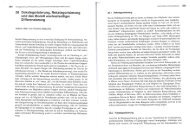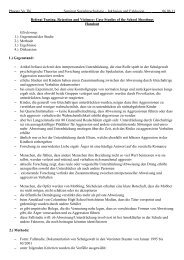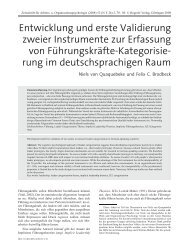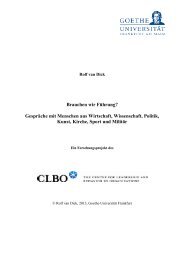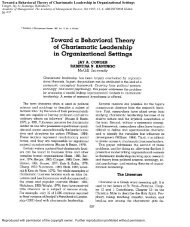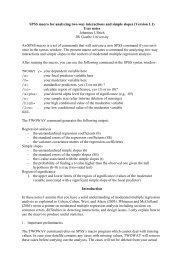Social Identity Theory and Self-categorization Theory: A Historical ...
Social Identity Theory and Self-categorization Theory: A Historical ...
Social Identity Theory and Self-categorization Theory: A Historical ...
You also want an ePaper? Increase the reach of your titles
YUMPU automatically turns print PDFs into web optimized ePapers that Google loves.
<strong>Social</strong> <strong>Identity</strong> <strong>Theory</strong> <strong>and</strong> <strong>Self</strong>-<strong>categorization</strong> <strong>Theory</strong> 215<br />
ongoing process to achieve, maintain, <strong>and</strong> protect a positive self-concept<br />
(broadly defined). It is unclear from this argument that one should<br />
expect low self-esteem people to display more bias, or that an act of bias<br />
would result in a spike in self-esteem. Turner never embraced the<br />
notion that there should be a literal <strong>and</strong> short-term correspondence<br />
between bias <strong>and</strong> self-esteem <strong>and</strong> in fact has actively distanced SIT from<br />
the self-esteem hypothesis (Turner, 1999).<br />
The debate regarding self-esteem provides a case study of the advantages<br />
<strong>and</strong> challenges associated with the ambitious scope of the social identity<br />
approach. The writings of Tajfel <strong>and</strong> colleagues touch on a huge number<br />
of issues relevant to group processes <strong>and</strong> intergroup relations, ranging from<br />
the political to the perceptual to the motivational. As such, it is frequently<br />
described as a ‘meta-theory’, a broad framework from which more specific<br />
theories can be inferred. When framing these more specific predictions,<br />
some researchers differ in their assumptions <strong>and</strong> interpretations, <strong>and</strong><br />
sometimes parallel versions of the theory seem to co-exist. This can result<br />
in tension, <strong>and</strong> can provide ammunition to those who argue that the<br />
theory is unfalsifiable. But this tension also means that the theory is<br />
constantly evolving <strong>and</strong> embracing new challenges. Some of these evolutions<br />
are discussed below.<br />
<strong>Social</strong> <strong>Identity</strong> Approach: Recent, Current, <strong>and</strong><br />
Future Directions<br />
In recent years, researchers in the field of social identity have made<br />
progress both internally (in terms of clarifying <strong>and</strong> elaborating the theory)<br />
<strong>and</strong> externally (in terms of using the theory to apply to new domains).<br />
An example of the internal evolution of the theory is the renewed<br />
attention given to its motivational basis. Although SCT offered no explicit<br />
motivational analysis to account for intergroup behaviour, cognitive<br />
contrasting of ingroups <strong>and</strong> outgroups is implicitly understood to be a<br />
strategy designed to promote separateness, perceptual clarity, <strong>and</strong> social<br />
meaning. In recent years, the motivation for distinctiveness <strong>and</strong> selfdefinition<br />
has replaced self-esteem as the most researched motive for<br />
group behaviour. The emphasis on group distinctiveness as a motivating<br />
force has resulted in qualifications of the similarity–attraction hypothesis<br />
of intergroup relations (Jetten, Spears, & Postmes, 2004), new ways of<br />
thinking about deviance (Abrams, Marques, Bown, & Henson, 2000), <strong>and</strong><br />
rejections of both assimilationist (Hornsey & Hogg, 2000) <strong>and</strong> ‘color-blind’<br />
(Brown & Hewstone, 2005) approaches to intergroup contact. Furthermore,<br />
Hogg (2000) has elaborated on the role of group distinctiveness in<br />
providing social meaning, arguing that many group processes – including<br />
identification, assimilation to norms, <strong>and</strong> intergroup bias – are partially<br />
underpinned by a need to reduce one’s subjective uncertainty about<br />
what to say, do, think, or feel.<br />
© 2008 The Author <strong>Social</strong> <strong>and</strong> Personality Psychology Compass 2/1 (2008): 204–222, 10.1111/j.1751-9004.2007.00066.x<br />
Journal Compilation © 2008 Blackwell Publishing Ltd









